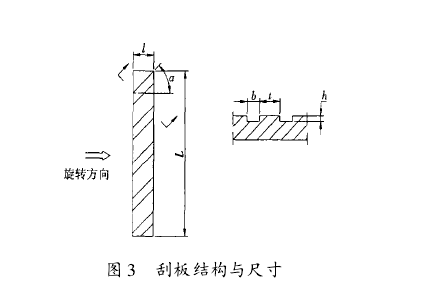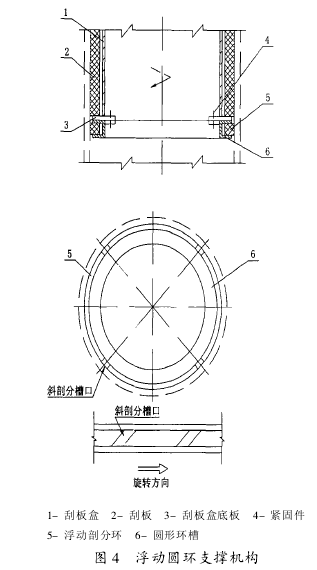The structure of the distiller is shown in Figure 2.

1 cylinder design molecular distiller drum aspect ratio L / D should usually be based on material properties and separation requirements within the range of 3 to 6, but in the end also through the structural design to be adjusted, that is, through the heater and condenser The size of the structure to decide. The cylinder must control the roundness and surface roughness to suit the needs of the squeegee movement and film formation. The length and the segment of the jacket are determined according to the parameters of the energy supply, the internal condenser structure and the specific size of the scraper. As shown in Fig. 2, when the energy source is a heat-conducting oil, a deflector can be considered inside the jacket to enhance the evaporation and heat transfer process of the heater. The cylinder and the upper and lower heads form a closed cavity. The connection must use a reliable sealing structure to meet the stringent requirements of the extremely high vacuum required by the molecular distillation process. In addition, according to the needs of the structure, a necessary process instrument interface, cooling water inlet and outlet, a steaming liquid, a steaming residual liquid outlet pipe and the like are opened on the cylinder body.
2 Drive and seal design The drive design of rotary wiper-type molecular stills is particularly important. The main points are: According to the material properties, type of scraper and speed, the installed power of the transmission is calculated; the motor type is selected according to the material properties and explosion-proof requirements. According to the speed and power required by the rotary scraper, the speed reducer is selected; the bracket type is selected according to the force conditions of the rotary shaft; according to the size of the rotary shaft of the distiller, whether the middle bearing and the bottom bearing are set is determined considering the processing, installation and maintenance. In order to ensure that the molecular distiller operates at a very high vacuum, a double-end mechanical seal structure is usually used. Even considering the magnetic fluid sealing structure under certain conditions. If the system has special requirements, magnetic drive design can also be considered. At this time, the dynamic seal at the rotary shaft will be changed into a static seal, which will better ensure the requirement of extremely high vacuum.

3 vacuum system design Molecular distillation system generally requires an operating pressure of 0.1 ~ 1.33Pa the following, its demand is very high, for this reason, when designing the vacuum system must pay attention to:
(1) Set the raw material liquid deaerator to remove air or volatile non-condensable components adsorbed inside the equipment. The degasifier should be designed in a variety of forms according to the specific requirements of the system: wall reflection type, laminate type, jet type, packing type, falling film type, etc.; scraper thin film evaporators are also used as raw material liquid degasser.
(2) A vacuum pump unit is used, that is, an oil diffusion pump and a mechanical scraper vacuum pump are connected in series to obtain a high vacuum degree of the system.
(3) Set the cold trap. In order to increase the efficiency of extremely high vacuum systems, a cold trap must be installed in front of the vacuum pump, and if necessary, a secondary cold trap may also be provided.
4 condenser design Condenser is an important part of the molecular distiller, the distance between the condenser and the evaporator is very important, should be calculated before the design, generally can be controlled within 20 cm; when the demand is high, you can control Within 5 cm. However, the distance between them is often limited by the shape of the squeegee mechanism. Therefore, the design of the squeegee structure is lightweight, flexible, and has sufficient strength and rigidity. In order to achieve the minimum size of the squeegee mechanism, it is necessary to shorten the condenser as much as possible. The distance between the evaporators. The condenser's modeling requirements are: enough condensing area must be available to facilitate the flow and discharge of condensate, and the cooling liquid inlet and outlet pipes must not interfere with the motion of moving parts, and a reliable condenser support must be provided. As shown in FIG. 2 , the upper and lower parts of the condenser are annular pipes, and a plurality of vertical condensing pipes are disposed between the upper and lower rings to facilitate the downward flow of condensate to the distilling liquid collection tank. The cooling pipe passes through the lower head, the inlet pipe is connected with the lower pipe pipe, and the outlet pipe is connected with the upper pipe pipe, so that the full flow of the cooling liquid can be ensured and the operation of the condensate is reversed.
4.5 Wiper device and its support design
(1) Wiper device The scraper of the molecular still is generally designed as a movable form. It uses the centrifugal force of the scraper block generated by the rotating shaft to make the scraper close to the inner wall of the cylinder, thus forming a thin and uniform layer on the inner wall. Liquid film, which greatly reduces the liquid film heat transfer, mass transfer resistance, increase the evaporation rate and separation efficiency. The main requirement for the cylinder is the roundness and surface roughness of the cylinder. The scraper is in many forms and its selection is one of the key issues in the design of molecular stills. According to the different material properties, especially the difference in viscosity, the scraper should be designed in different forms, which can be designed with reference to the scraper film evaporator. The most commonly used scraper is a Smith type. Its structural feature is that the scraper opens a certain number of chutes. When designing, it is necessary to set a sufficient notch width and spacing according to the number of scrapers, the amount of liquid handled, and the rotation speed. According to material characteristics, scraper material can choose PTFE, laminates, graphite and so on. The circumferential speed of the end of the scraper is generally controlled at 1.5-5 m/s. The specific linear velocity must be ensured that the liquid does not “run away†due to too slow rotation speed and does not appear “drywall†due to excessive rotation speed. The direction of rotation of the scraper must be compatible with the direction of the chute open by the scraper, that is, the material should produce a downward spiral movement; if the opposite direction, the liquid upward, the liquid film thickens, destroy the flow field, no effect . Scraper structure and dimensions are shown in Figure 3.
(2) squeegee support The squeegee support design includes two problems: the support of the squeegee itself and the support technology of the wiper end of the wiper device. The movable squeegee is usually supported in a scraper box that is open on one side so that the squeegee slides out and sticks against the inner wall of the drum under the effect of a rotating centrifugal force. The lower end plate of the squeegee box supports the squeegee when the vehicle is parked, and the upper end plate of the squeegee box plays the role of preventing the squeegee from coming out during working, so as to counteract the upward force generated when the screed chute squeezes the feed liquid downward.
Due to the blockage of the internal condenser, there is a cantilever problem at the lower end of the wiper device, as shown in FIG. 2 . In order to improve the rotational stiffness of the cantilever wiper device, a "floating ring support mechanism" may be used here, as shown in FIG. This is a circular ring groove connected to the scraper box, which is equipped with a split ring that can be opened under the action of centrifugal force and is provided with a chute.

6 Design of demisters The molecular distiller works at extremely high vacuum. As mentioned earlier, the feed liquid molecules on the evaporation surface fly toward the condenser surface in a jetting manner. This high-speed motion often entrains a large number of droplets, which seriously affects the separation efficiency and separation accuracy. For this purpose, a "ring demister" should be provided on the annular space between the evaporation surface and the condensing surface to improve the quality of the high purity material separation in molecular distillation equipment.
Related equipment: Kjeldahl digestion digester
Soft-sealing Gate Valve,Low Pressure Gate Valve,Non-rising Stem Gate Valve
Baoding Valvula Imp & Exp Trading Co., Ltd. , http://www.hbvalves.com